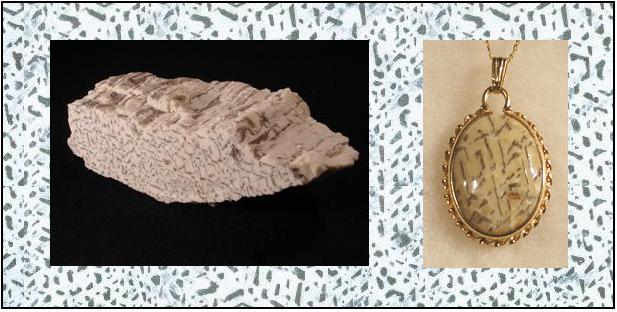Rus-
( Fr- graphique
granit/pierre
hébraïque/; Ger- Schriftgranit;
Nor- skriftgranitt;
Rus- ![]() )
)
GRAPHIC GRANITE

A. Graphic granite specimen (greatest dimension ~12 cm) from Berry pegmatite, Poland, Maine. The Hadleigh Collection. (© photo by F.C. Wilda, www.naturesfinestcreations.com)
B. Graphic granite cabochon pendant (greater axis of cabochon - 3.0 cm) fashioned by Frederick C. Wilda from rock collected at the Berry pegmatite, Poland, Maine. The Hadleigh Collection. (© photo by F.C. Wilda, www.naturesfinestcreations.com)
C. Graphic granite background.
Tiled image of polished surface (vertical dimension ~7.5 cm) cut
perpendicular to
the length of the quartz "rods". (© photo by Dick Dietrich)
[See also
Figure 27 in the MIMETOLITH file on this web site.]
DESCRIPTION: Typical graphic granites
consist
of nearly parallel rodlike masses of quartz surrounded by feldspar --
see Figure A. The quartz:feldspar ratio in these rocks ranges
from about 10:90 to 50:50 -- i.e., the feldspar component is
greater in nearly all specimens.
Colors - felsdpar "host" may be off white,
cream, tan, pink or salmon; quartz ranges from nearly colorless
through white to smoky. The feldspar -- typically perthitic,
commonly macroperthitic so the volume of the potassium feldspar
can be seen to exceed that of the plagioclase - - of virtually all
individual specimens comprise single grains.
H. 6 (feldspar), 7 (quartz)
S.G. ~2.6 -- i.e., 2.574 (feldspar)
and 2.65 (quartz)
Light transmission -overall subtransparent
to opaque
Luster - pearly to
dull (feldspar), vitreous on fractures (quartz)
Breakage - tends to break along
cleavage planes of feldspar and/or away from the quartz rods (i.e., so-to-speak freeing them from
the surrounding feldspar)
Miscellaneous
- Appearance, often referred to as an "intergrowth" of alkali feldspar
and quartz, is the definitive characteristic.
OTHER NAMES:
USES: As gemstones -- typically cabochons or free forms -- for pieces such as pendants; spheres (some extremely attractive!); relatively large pieces such as desk sets and bookends.
OCCURRENCES: In some, but not all, granitic pegmatite masses and as clasts in, for example, beach shingles and glacial debris derived from those masses.
NOTEWORTHY LOCALITIES: So far as its use as a gem rock, none in particular; however, graphic granite should be looked for wherever granitic pegmatites occur -- e.g., in the Piedmont Province of Virginia and North Carolina. Three locations of pegmatites masses where I have found good specimens are: near Pala, San Diego County, California; at Bedford, Westchester County, New York; and near Custer, Custer County, South Dakota. In addition, I have also collected graphic granite pebbles and cobbles, which have been fashioned into pendants, from glacial debris in Michigan and from beaches along northern Lake Michigan and southern Lake Superior. And, some noteworthy specimens in the CMU student collections are labeled as coming from near Ohio, Gunnison County, Colorado. Also, my attention was recently directed to a photograph of an especially fine specimen of graphic granite from the Talacha pegmatite field, which is near the Duldurginsky granite massif in Agin-Buryat Autonomous Okrug -- i.e., about 150 km south of the city of Chita, which is in theTransbaikal region, east of Lake Baikal, Russia (Margarita I. Novgorodova, personal communication, August, 2005).From an historical standpoint, and interesting
petrographically, the term
pegmatite -- currently used widely to describe coarse-grained
igneous/igneoid (e.g., granitic) rocks -- was originally
applied by L'Abbe Hauy to graphic
granite (Brongniart, 1813, p.32). Hauy's use is quite
understandable when one considers the derivation of the word pegmatite
-- from the Greek πηγματ meaning “thing joined together or
conglutinated” + ite (OED), certainly in allusion to the intimate
"intergrowth" of the alkali feldspar and quartz of graphic granite.
These "intergrowths" range in size from microscopic to the gemrock material with individual feldspar grains up to several decimeters in greatest dimension and quartz rods up to several centimeters long. The term "intergrowth" is enclosed herein by quotation marks because there is less than a consensus among petrologists as to how these rocks originated: Some consider them true intergrowths -- i.e., that the feldspar and quartz formed as the result of essentially simultaneous crystallization; others conclude that the quartz represents partial replacement of previously crystallized feldspar grains; and others offer other hypotheses or suggest that each occurrence needs to be considered individually and some may have originated one way and others other ways. For those interested in the genesis or geneses of this gemrock, several articles are in geological publications (see, for example, Barker, 1970 and Fenn, 1986).
Early use of graphic granite as a decorative
stone is
shrouded in antiquity. More recently, it was incorporated in the
façade
of one of the Vitelli family Palaces, built during the late 15th
or
early 16th century at Città di Castello,Italy
(www.salviani.it). Currently, “graphic granite is used by
cooperatives and amateur craftsmen as a decorative material” in the
Chelyabinsk region of the southern Urals, Russia -- i.e., at the
Taiginka graphite deposit (www.fipc.ru) -- as well as by several
lapidaries here and there throughout the world .
R. V. Dietrich © 2015
Last
update: 16 August 2005
web page created by Emmett Mason